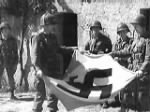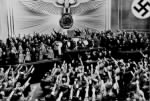fter World War I, Germany faced a time of depression and political upheaval that created a favorable environment for Hitler and the Nazi Party to take power. During his reign as Führer, Hitler strengthened the German economy and expanded the German Empire, but this aggressive strategy in Europe caused World War II and the deaths of millions of Jews and “undesirables” in concentration camps. The Nazi Reich taught the world how hatred and power could build up a nation, but would ultimately destroy it.
Nazi Germany
A
Nazi Strongholds: Capital City
Berlin, Germany
Nazi Strongholds: Berghof, Hitler's Residence
Berchtesgaden, Germany
Other: Nazi Army invades Poland
Sep 1, 1939
Other: Nazis invade Yugoslavia and Greece
Apr 6, 1941
Other: Nazi Army occupies Bulgaria
Mar 2, 1941
Other: Hermann Göring captured
May 9, 1945
Other: First day of the Nuremberg Trials
Nov 20, 1945
Other: Potsdam Conference dismantles the Nazi state
Aug 1945
Other: Nazi Army invades Romania
Oct 7, 1940
Other: Nazi Army surrenders at Stalingrad
Feb 2, 1943
Other: Nazi Army invades the Soviet Union
Jun 22, 1941
Other: Nazi Army invades Denmark and Norway
Apr 9, 1940
Other: Nazi Army invades France, Belgium, and Holland
May 10, 1940
Other: Tripartite (Axis) Pact signed
Sep 27, 1940
Other: Hitler commits suicide in his bunker
Apr 30, 1945
Other: National Flag
Swastika flag
Other: National Anthem
Deutschlandlied
Other: Political Party in power
National Socialist German Workers Party (NSDAP or Nazi Party)
Other: Government
Totalitarian, Controlled by the Nazi party, built upon Fascist principles but Nazis never declared themselves as Fascist
Other: Economy
Mixed, contained aspects of both a free market and a centrally planned economy.
Other: Hitler declares himself Fuhrer
Aug 2, 1934
Other: The Gestapo is created by Hermann Göring
Apr 26, 1933
Other: Failed Beer Hall Putsch
1923
Other: Hitler appointed Chancellor of Germany
Jan 30, 1933
Other: Night of the Long Knives
Jun 30, 1934
Other: Dachau concentration camp opens
Mar 22, 1933
Other: Nazi-Soviet Non-Aggression Pact signed
Aug 23, 1939
Other: Reichstag fire
Feb 27, 1933
Other: Kristallnacht (“Night of Broken Glass”)
Nov 9, 1938
Other: Nazi Army occupies the Rhineland
Mar 6, 1936
Other: Nazi Army takes Czechoslovakia
Mar 15, 1939
Other: Hitler begins his quest for Lebensraum
1938
Other: Munich Conference
Sep 29, 1938
Other: Nazi Army occupies the Sudetenland
Oct 15, 1938
Other: Mein Kampf (My Struggle) published
1925
Other: Anschluss, Germany annexes Austria
Mar 12, 1938
Other: Berlin hosts the Olympics
Other: Nuremberg Laws
Sep 15, 1935
Nazi Strongholds: Führerhauptquartier Wolfsschanze, Wolf's Lair
Ketrzyn, Poland
Adolf Hitler
Chancellor, 1933-1945; Führer, 1934-1945
Karl Adolf Eichmann
headed Gestapo Department IV B4 for Jewish Affairs; “Jewish Specialist.”
Reinhard Heydrich
Second in SS organization, lead planner of Hitler’s Final Solution.
Hans Frank
Governor-General of Occupied Poland, perpetuated the Holocaust in Poland.
Martin Bormann
Head of the Party Chancellery and private secretary to Adolf Hitler.
Joseph Goebbels
Minister of Nazi Propaganda; succeeded Hitler as chancellor for one day; On May 1, 1945, he committed suicide
Rudolf Hess
Deputy Führer, number three after Göring.
Heinrich Himmler
Head of the German SS, Reichsführer-SS; committed suicide in Luneburg by potassium cyanide
Hermann Göring
President of the Reichstag, commander of the Luftwaffe (German Air Force), committed suicide after Nuremberg trials
Owner:Clio
Anyone can contribute
Created:Nov 19, 2008
Modified: Mar 30, 2012
View Count: 2,867(Recent: 1)
Fold3, Nazi Germany (https://www.fold3.com/memorial/83002423/nazi-germany : accessed Nov 5, 2024), database and images, https://www.fold3.com/memorial/83002423/nazi-germany







